Study on Effects of Operating Parameters on a Water-Cooled Loop Thermosyphon System under Partial Server Utilization
Abstract
:1. Introduction
2. Experimental Method
2.1. Experimental Setup
2.2. Test Conditions and Results
3. Numerical Model
- The working fluids in the evaporator and condenser have a one-dimensional homogeneous flow;
- The airflow was evenly distributed among the micro channel exchanger;
- There was no air backflow or leakage in the rack;
- The refrigerant flow rate, temperature, and pressure were evenly distributed in every channel of the heat exchanger;
- The acceleration pressure drop of the working fluids was neglected;
- The axial heat transfer and heat dissipation of the working fluids were neglected.
3.1. Evaporator Module
3.2. Condenser Module
3.3. Connection Tube Module
3.4. Model Verification
4. Analysis and Discussion
4.1. Simulation Conditions
4.2. Effect of Airside Operating Parameter on Thermal Performance
4.3. Effects of Water Side Operating Parameters on Thermal Performance
5. Conclusions
- When the airflow rate and heating load decreased, the effective refrigerant mass flow rate was significantly lower than the measured refrigerant mass flow rate. The additional liquid refrigerant reduced the heat transfer performance of the LTS and aggravated a drop in cooling capacity. However, the LTS can still ensure the thermal safety of the data center under low airflow rates and partial server heating loads.
- The airflow rate of the LTS could be adjusted according to the upper limit of the server exhaust air temperature to accurately reduce the excessive cooling capacity under partial server utilization. The excessive cooling capacity was reduced by 14.5–52.1% with a decrease in the airflow rate under 5–56.5% server utilizations.
- Under partial server utilization, the water side operating parameters could be adjusted according to the upper limit of the rack’s average outlet air temperature to reduce the excessive cooling capacity. Increasing the supply chilled water temperature from 10 °C to 18 °C or decreasing the water flow rate from 2.1 m3/h to 0.9 m3/h reduced more than 23.8% of the excessive cooling capacity.
Further Study
- In this study, several suggestions for operating parameters optimization were put forward to reduce the excessive cooling capacity of the LTS and ensure thermal security of the data center. However, the specific energy-saving effects of these suggestions have not been studied, and further research is required.
- To reduce the excessive cooling capacity and ensure thermal safety, multiple operating parameters need to be adjusted quickly and precisely by the control system, which involves a multi-objective multi-parameter optimization problem. Therefore, the use of artificial intelligence or machine learning methods to solve this problem quickly deserves further research.
Author Contributions
Funding
Institutional Review Board Statement
Informed Consent Statement
Data Availability Statement
Conflicts of Interest
References
- Zhang, W.; Zhang, S.; Wang, X.; Qiao, J.; Zhang, J.; Kong, W. Lighting up the Green Cloud: A Study on Energy Consumption and Renewable Energy Usage Potential of Data Centers in China; North China Electric Power University: Beijing, China, 2019. [Google Scholar]
- Nadjahi, C.; Louahlia, H.; Lemasson, S. A review of thermal management and innovative cooling strategies for data center. Sustain. Comput. Inform. Syst. 2018, 19, 14–28. [Google Scholar] [CrossRef]
- Ham, S.-W.; Kim, M.-H.; Choi, B.-N.; Jeong, J.-W. Simplified server model to simulate data center cooling energy consumption. Energy Build. 2015, 86, 328–339. [Google Scholar] [CrossRef]
- Zhang, Y.; Zhao, Y.; Dai, S.; Nie, B.; Ma, H.; Li, J.; Miao, Q.; Jin, Y.; Tan, L.; Ding, Y. Cooling technologies for data centres and telecommunication base stations—A comprehensive review. J. Clean. Prod. 2022, 334, 130280. [Google Scholar] [CrossRef]
- Chen, Y.; Zhang, Y.; Meng, Q. Study of ventilation cooling technology for telecommunication base stations in Guangzhou. Energy Build. 2009, 41, 738–744. [Google Scholar] [CrossRef]
- Bao, L.; Wang, J.; Kang, L. The applied effect analysis of heat exchanger installed in a typical communication base station in Beijing of China. Energy Procedia 2012, 14, 620–625. [Google Scholar] [CrossRef]
- Clidaras, J.; Stiver, D.W. Water-Based Data Center. U.S. Patent 07525207B2, 28 April 2009. [Google Scholar]
- Habibi Khalaj, A.; Scherer, T.K.; Halgamuge, S. Energy, environmental and economical saving potential of data centers with various economizers across Australia. Appl. Energy 2016, 183, 1528–1549. [Google Scholar] [CrossRef]
- Díaz, A.J.; Cáceres, R.; Torres, R.; Cardemil, J.M.; Silva-Llanca, L. Effect of climate conditions on the thermodynamic performance of a data center cooling system under water-side economization. Energy Build. 2020, 208, 109634. [Google Scholar] [CrossRef]
- Lu, H.; Zhang, Z.; Yang, L. A review on airflow distribution and management in data center. Energy Build. 2018, 179, 264–277. [Google Scholar] [CrossRef]
- Tatchell-Evans, M.; Kapur, N.; Summers, J.; Thompson, H.; Oldham, D. An experimental and theoretical investigation of the extent of bypass air within data centres employing aisle containment, and its impact on power consumption. Appl. Energy 2017, 186, 457–469. [Google Scholar] [CrossRef]
- Jin, C.; Bai, X.; Yang, C. Effects of airflow on the thermal environment and energy efficiency in raised-floor data centers: A review. Sci. Total Environ. 2019, 695, 133801. [Google Scholar] [CrossRef]
- Zhang, H.; Shao, S.; Xu, H.; Zou, H.; Tang, M.; Tian, C. Simulation on the performance and free cooling potential of the thermosyphon mode in an integrated system of mechanical refrigeration and thermosyphon. Appl. Energy 2017, 185, 1604–1612. [Google Scholar] [CrossRef]
- Tian, H.; He, Z.; Li, Z. A combined cooling solution for high heat density data centers using multi-stage heat pipe loops. Energy Build. 2015, 94, 177–188. [Google Scholar] [CrossRef]
- Ding, T.; He, Z.G.; Hao, T.; Li, Z. Application of separated heat pipe system in data center cooling. Appl. Therm. Eng. 2016, 109, 207–216. [Google Scholar] [CrossRef]
- Ling, L.; Zhang, Q.; Yu, Y.; Liao, S.; Sha, Z. Experimental study on the thermal characteristics of micro channel separate heat pipe respect to different filling ratio. Appl. Therm. Eng. 2016, 102, 375–382. [Google Scholar] [CrossRef]
- Ding, T.; Cao, H.W.; He, Z.G.; Li, Z. Experiment research on influence factors of the separated heat pipe system, especially the filling ratio and Freon types. Appl. Therm. Eng. 2017, 118, 357–364. [Google Scholar] [CrossRef]
- Zhang, H.; Shi, Z.; Liu, K.; Shao, S.; Jin, T.; Tian, C. Experimental and numerical investigation on a CO2 loop thermosyphon for free cooling of data centers. Appl. Therm. Eng. 2017, 111, 1083–1090. [Google Scholar] [CrossRef]
- Tong, Z.; Zang, G. Effect of the diameter of riser and downcomer on an CO2 thermosyphon loop used in data center. Appl. Therm. Eng. 2021, 182, 116101. [Google Scholar] [CrossRef]
- Ding, T.; wen Cao, H.; guang He, Z.; da Wu, J.; Li, Z. Experimental study on a loop thermosyphon cooling system in data centers using CO2 as a working Fluid, especially thermal environment and energy-saving effect. Appl. Therm. Eng. 2020, 175, 115359. [Google Scholar] [CrossRef]
- Ling, L.; Zhang, Q.; Yu, Y.; Liao, S. Experimental investigation on the thermal performance of water cooled multi-split heat pipe system (MSHPS) for space cooling in modular data centers. Appl. Therm. Eng. 2016, 107, 591–601. [Google Scholar] [CrossRef]
- China Refrigeration Society Data Center Cooling Working Group. Annual Research Report on Cooling Technology Development 2017; China Architecture & Building Press: Beijing, China, 2018. [Google Scholar]
- Pelley, S.; Meisner, D.; Wenisch, T.F.; Vangilder, J.W.; Understanding and Abstracting Total Data Center Power. In Workshop on Energy-Efficient Design; 2009. Available online: https://citeseerx.ist.psu.edu/document?repid=rep1&type=pdf&doi=c9f3ff0a7c7c823ca3994144f33eb7ee1b31f396 (accessed on 7 March 2022).
- Zou, S.; Zhang, Q.; Yue, C.; Wang, J.; Du, S. Study on the performance and free cooling potential of a R32 loop thermosyphon system used in data center. Energy Build. 2022, 256, 111682. [Google Scholar] [CrossRef]
- Whelan, B.P.; Kempers, R.; Robinson, A.J. A liquid-based system for CPU cooling implementing a jet array impingement waterblock and a tube array remote heat exchanger. Appl. Therm. Eng. 2012, 39, 86–94. [Google Scholar] [CrossRef]
- Vilarrubí, M.; Riera, S.; Ibañez, M.; Omri, M.; Laguna, G.; Frechette, L.; Barrau, J. Experimental and numerical study of micro-pin-fin heat sinks with variable density for increased temperature uniformity. Int. J. Therm. Sci. 2018, 132, 424–434. [Google Scholar] [CrossRef]
- Moffat, R.J. Describing uncertainties in experimental results. Exp. Therm Fluid Sci. 1988, 1, 3–17. [Google Scholar] [CrossRef]
- Zou, S.; Zhang, Q.; Ling, L.; Wang, J.; Ma, X.; Du, S.; Yue, C. Experimental investigation on the thermal performance of a water-cooled loop thermosyphon system under fan failure conditions. Int. J. Refrig. 2021, 124, 85–95. [Google Scholar] [CrossRef]
- Yang, S.; Tao, W. Heat Transfer, 4th ed.; Higher Education Press: Beijing, China, 2006. [Google Scholar]
- Lemmon, E.W.; Huber, M.L.; Mclinden, M.O.; NIST Standard ReferenceDatabase 23. Reference Fluid Thermodynamic and Transport Properties-REFPROP. 9.0, 2010. Available online: https://www.techstreet.com/standards/nist-refprop-9-0?product_id=1772426 (accessed on 10 May 2022).
- Gnielinski, V. New Equations for Heat and Mass Transfer in Turbulent Pipe and Channel Flows. Int. J. Chem. Eng. 1976, 16, 359–367. [Google Scholar]
- Muley, A.; Manglik, R.M. Experimental Study of Turbulent Flow Heat Transfer and Pressure Drop in a Plate Heat Exchanger With Chevron Plates. Trans. ASME 1999, 121, 110–117. [Google Scholar] [CrossRef]
- Shah, M.M. Unified correlation for heat transfer during boiling in plain mini/micro and conventional channels. Int. J. Refrig. 2017, 74, 606–626. [Google Scholar] [CrossRef]
- Friedel, L. Improved Friction Pressure Drop Correlation for Horizontal and Vertical Two-Phase Pipe Flow. In Proceedings of the European Two-Phase Flow Group Meet, Ispra, Italy, 5–8 June 1979; Volume 18, pp. 485–491. [Google Scholar]
- Han, D.-H.; Lee, K.-J.L.; Kim, Y.-H.K. The Characteristics of Condensation in Brazed Plate Heat Exchangers with Different Chevron Angles. J. Korean Phys. Soc. 2003, 43, 66–73. [Google Scholar]
- Shah, R.K. Plate Heat Exchangers and Their Design Theory; Heat Transfer Equipment Design: Washington, DC, USA, 1988. [Google Scholar]
- Coleman, J.W. An Experimentally Validated Model for Two-Phase Sudden Contraction Pressure Drop in Microchannel Tube Headers. Heat Transf. Eng. 2004, 25, 69–77. [Google Scholar] [CrossRef]
- Kim, M.H.; Bullard, C.W. Air-side thermal hydraulic performance of multi-louvered fin aluminum heat exchangers. Int. J. Refrig 2002, 25, 390–400. [Google Scholar] [CrossRef]
- Chang, Y.J.; Wang, C.C. A generalized heat transfer correlation for Iouver fin geometry. Int. J. Heat Mass Transf. 1997, 40, 533–544. [Google Scholar] [CrossRef]
- Dong, J.; Chen, J.; Chen, Z.; Zhang, W.; Zhou, Y. Heat transfer and pressure drop correlations for the multi-louvered fin compact heat exchangers. Energy Convers. Manag. 2007, 48, 1506–1515. [Google Scholar]
- Kim, N.H.; Cho, J.P. Air-side performance of louver-finned flat aluminum heat exchangers at a low velocity region. Heat Mass Transf. 2008, 44, 1127–1139. [Google Scholar] [CrossRef]
- Zhang, Q.; Huang, X.; Zou, S. Numerical Investigation on Thermal Performance of Micro Channel Separate Heat Pipe under Low Airflow Rate. J. Hunan Univ. Nat. Sci. 2020, 47, 149–156. [Google Scholar]
- Yue, C.; Zhang, Q.; Zhai, Z.; Ling, L. CFD simulation on the heat transfer and flow characteristics of a microchannel separate heat pipe under different filling ratios. Appl. Therm. Eng. 2018, 139, 25–34. [Google Scholar] [CrossRef]
- Gungor, K.E.; Winterton, R. A general correlation for flow boiling in tubes and annuli. Int. J. Heat Mass Transf. 1986, 29, 351–358. [Google Scholar] [CrossRef]
- Li, W.; Wu, Z. A general criterion for evaporative heat transfer in micro/mini-channels. Int. J. Heat Mass Transf. 2010, 53, 1967–1976. [Google Scholar] [CrossRef]
- Kandlikar, S.G. A General Correlation for Saturated Two-Phase Flow Boiling Heat Transfer Inside Horizontal and Vertical Tubes. J. Heat Transf. 1990, 112, 219–228. [Google Scholar] [CrossRef]
- GB50174-2017; Code for Design of Data Centers. China Planning Publishing House: Beijing, China, 2017.
- European Space Research and Technology Centre (Noordwijk); Mechanical Systems Division, European Space Agency. Heat Pipe Qualification Requirements; ESA PSS-49 Issues 2; ESA Scientific and Technical Publications Branch: Paris, France, 1983. [Google Scholar]
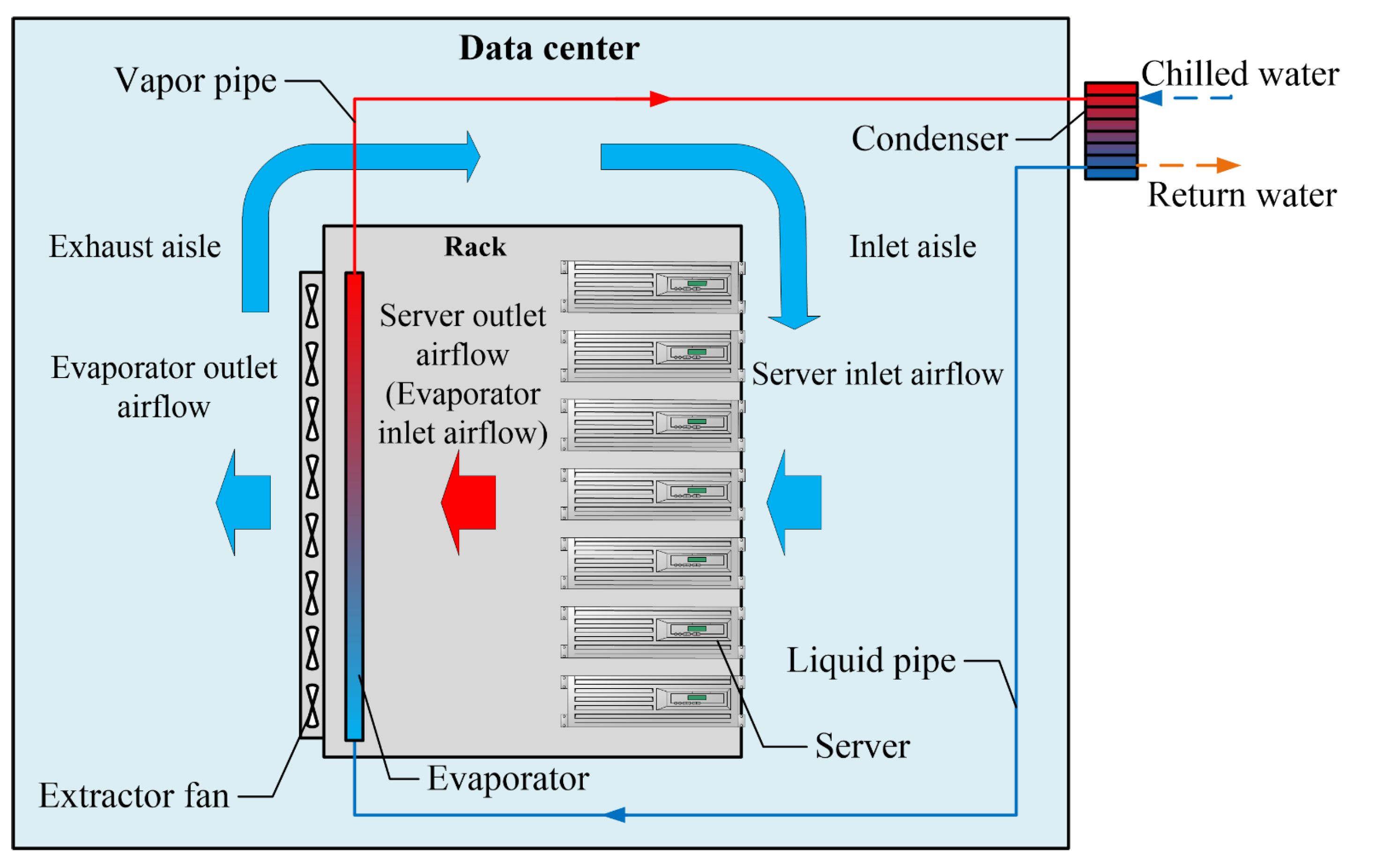
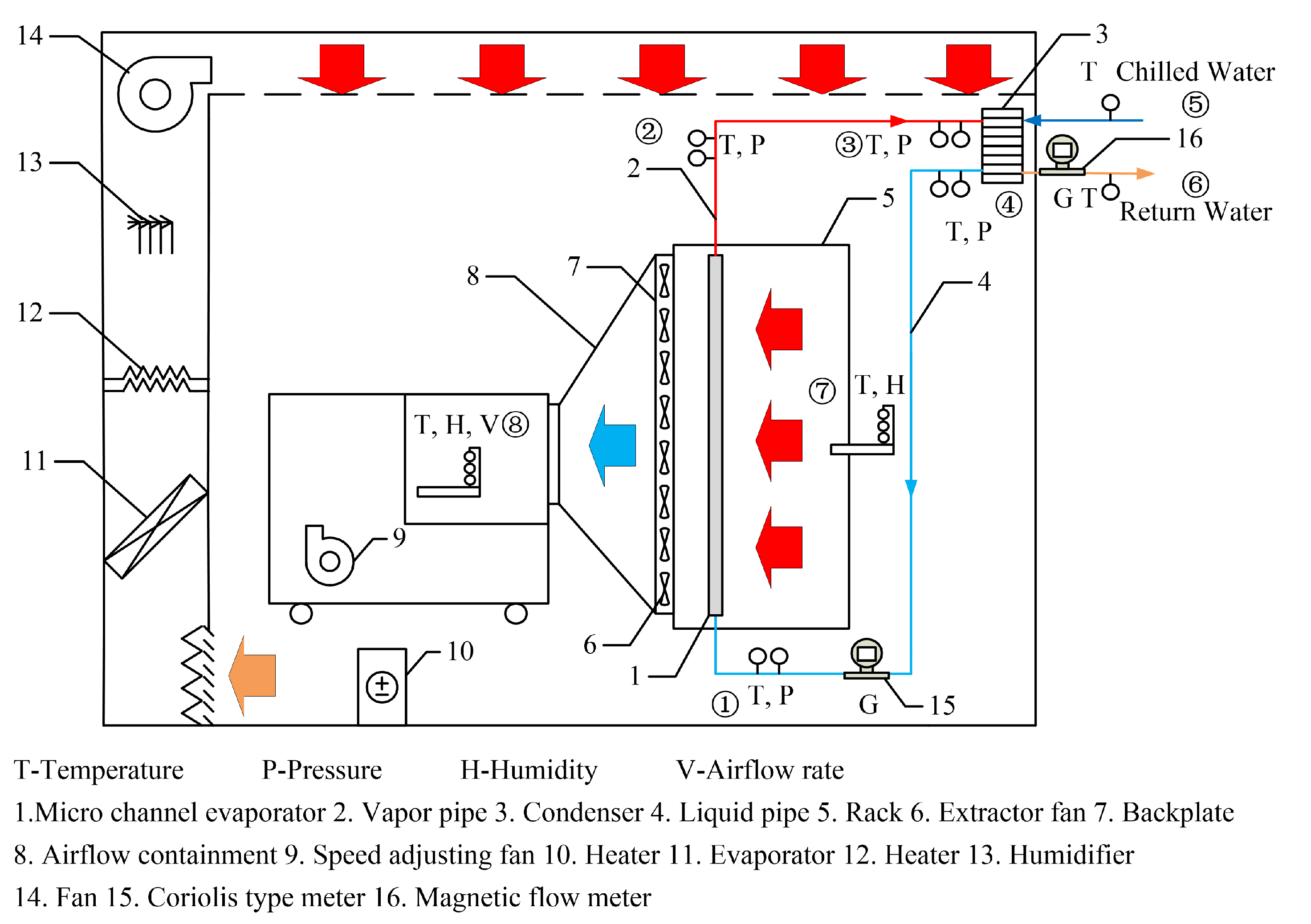
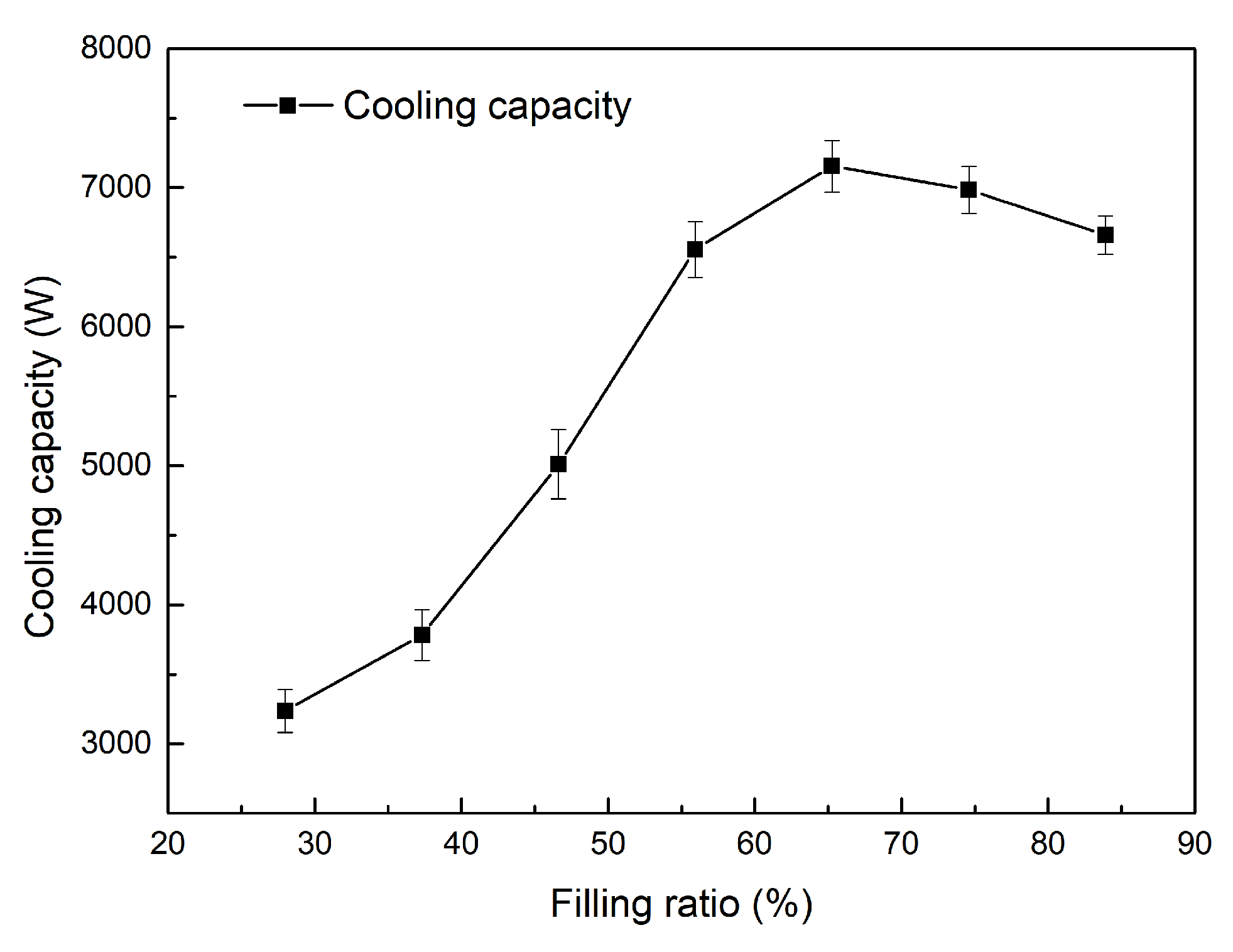
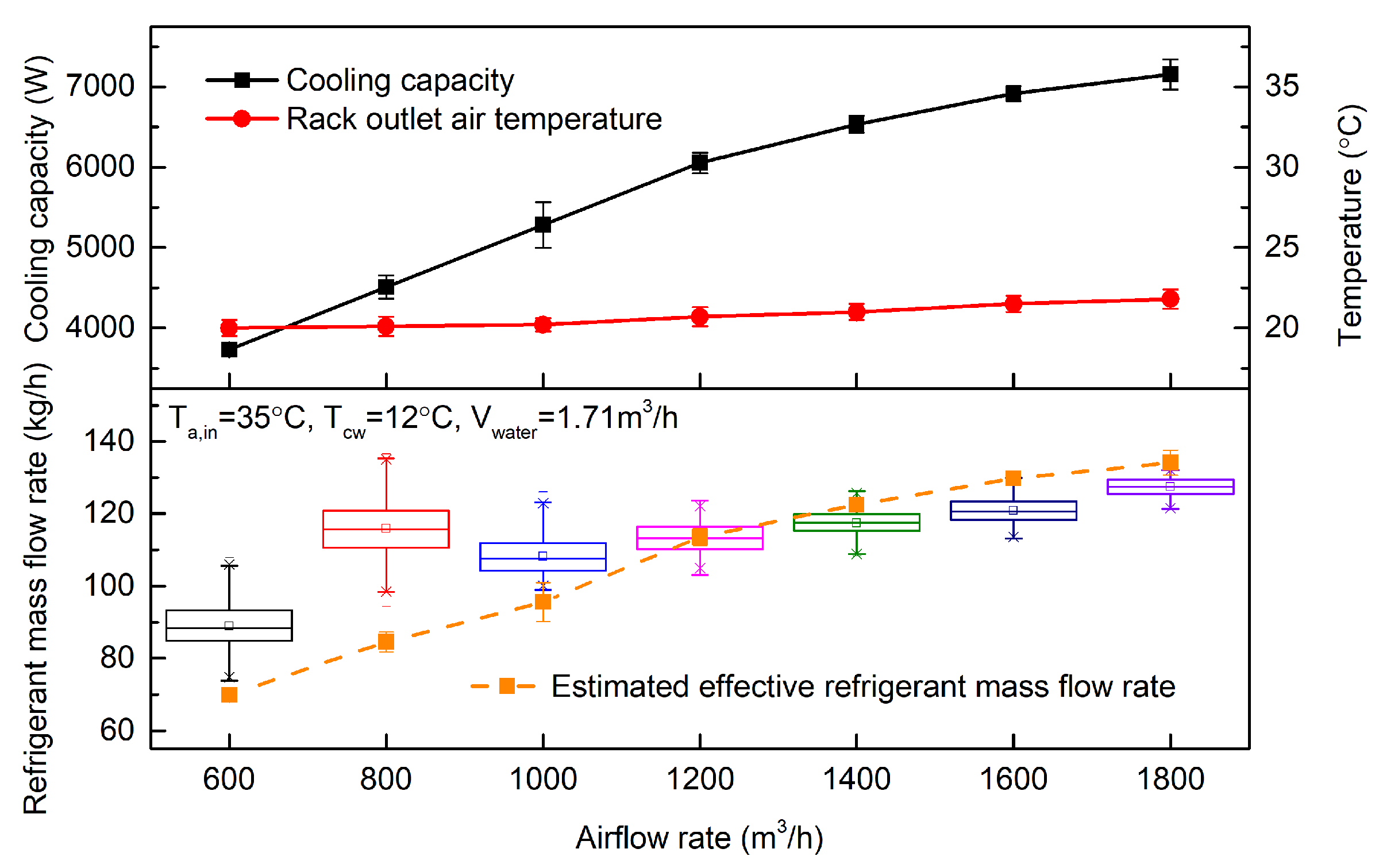
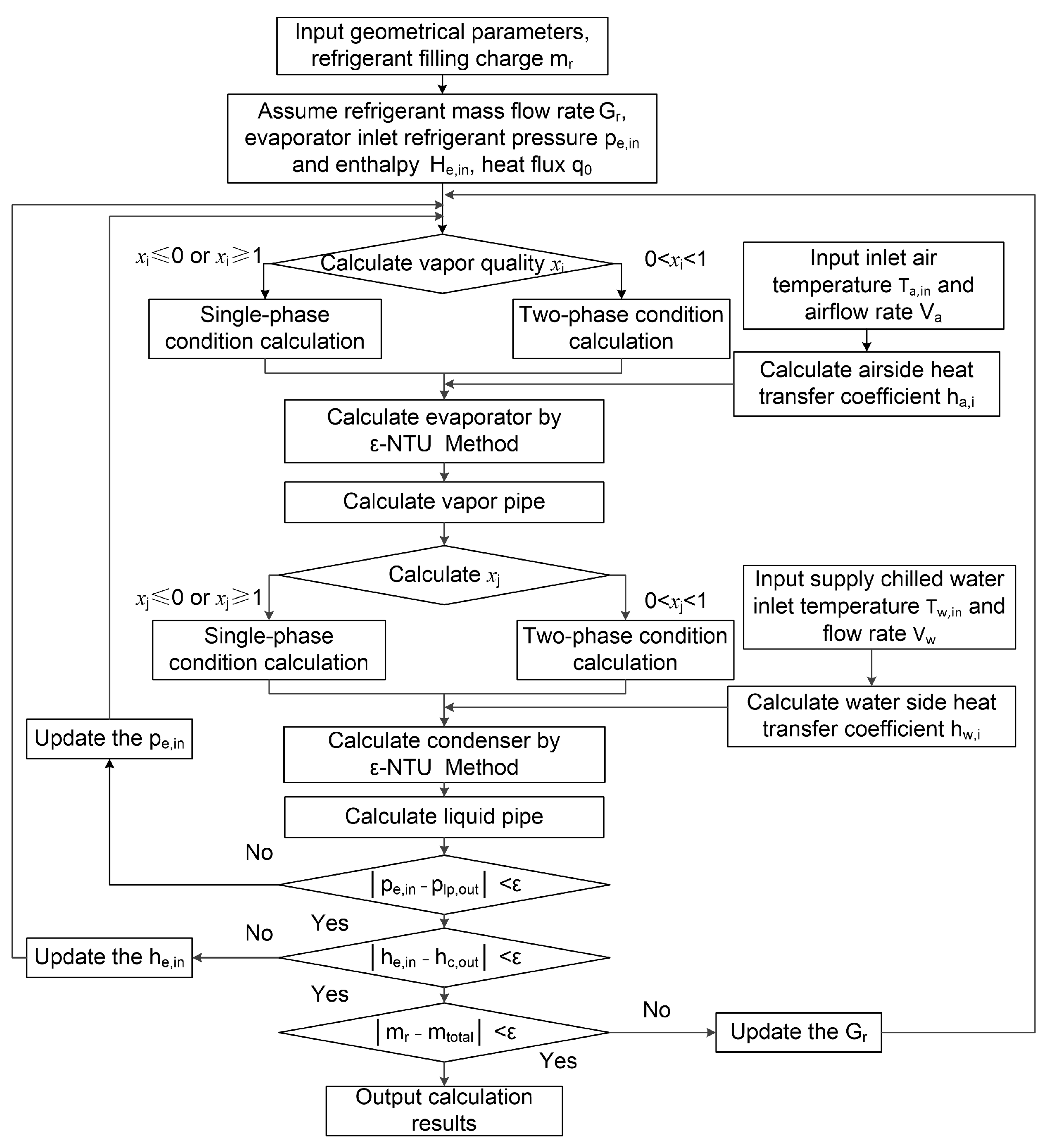
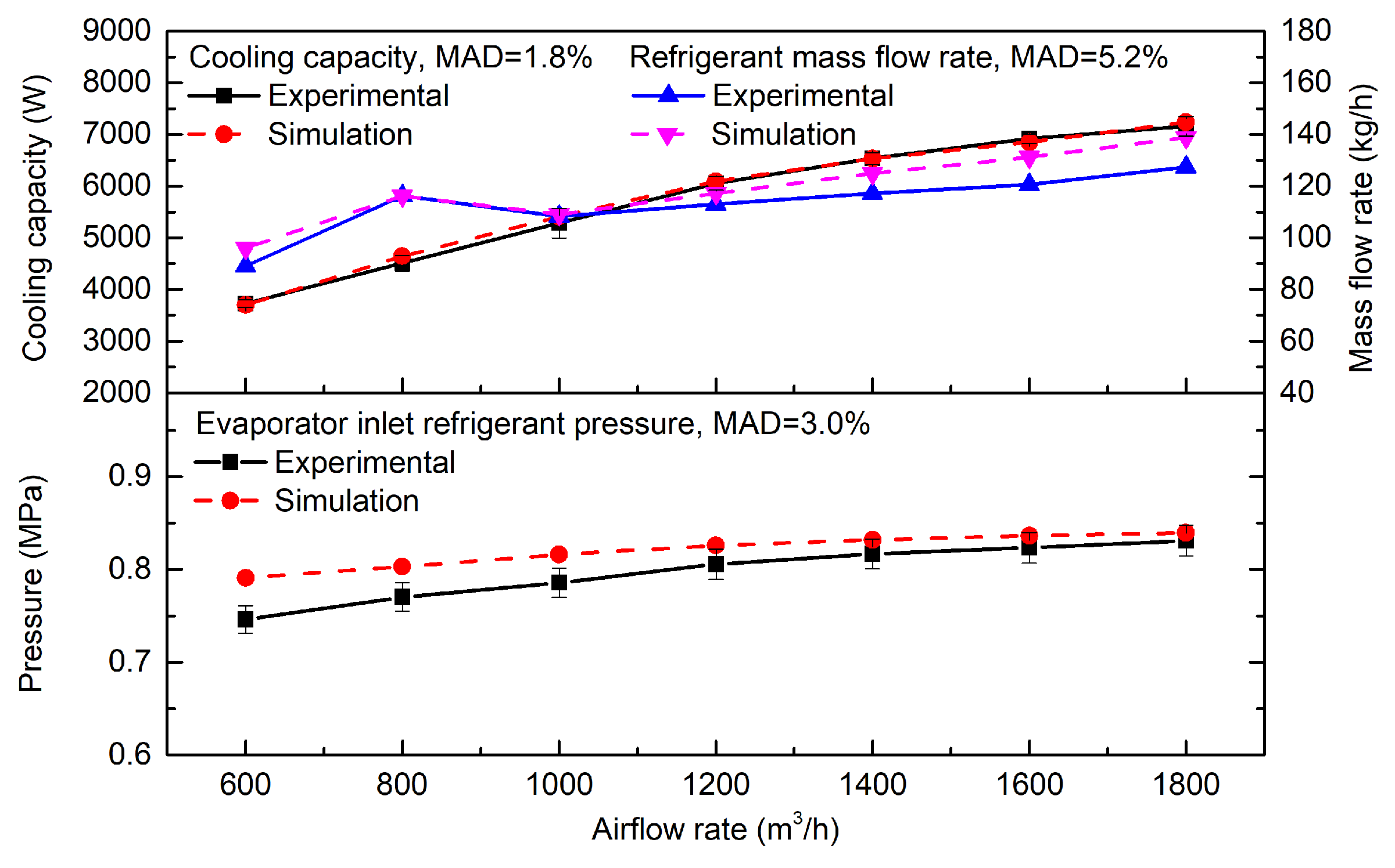

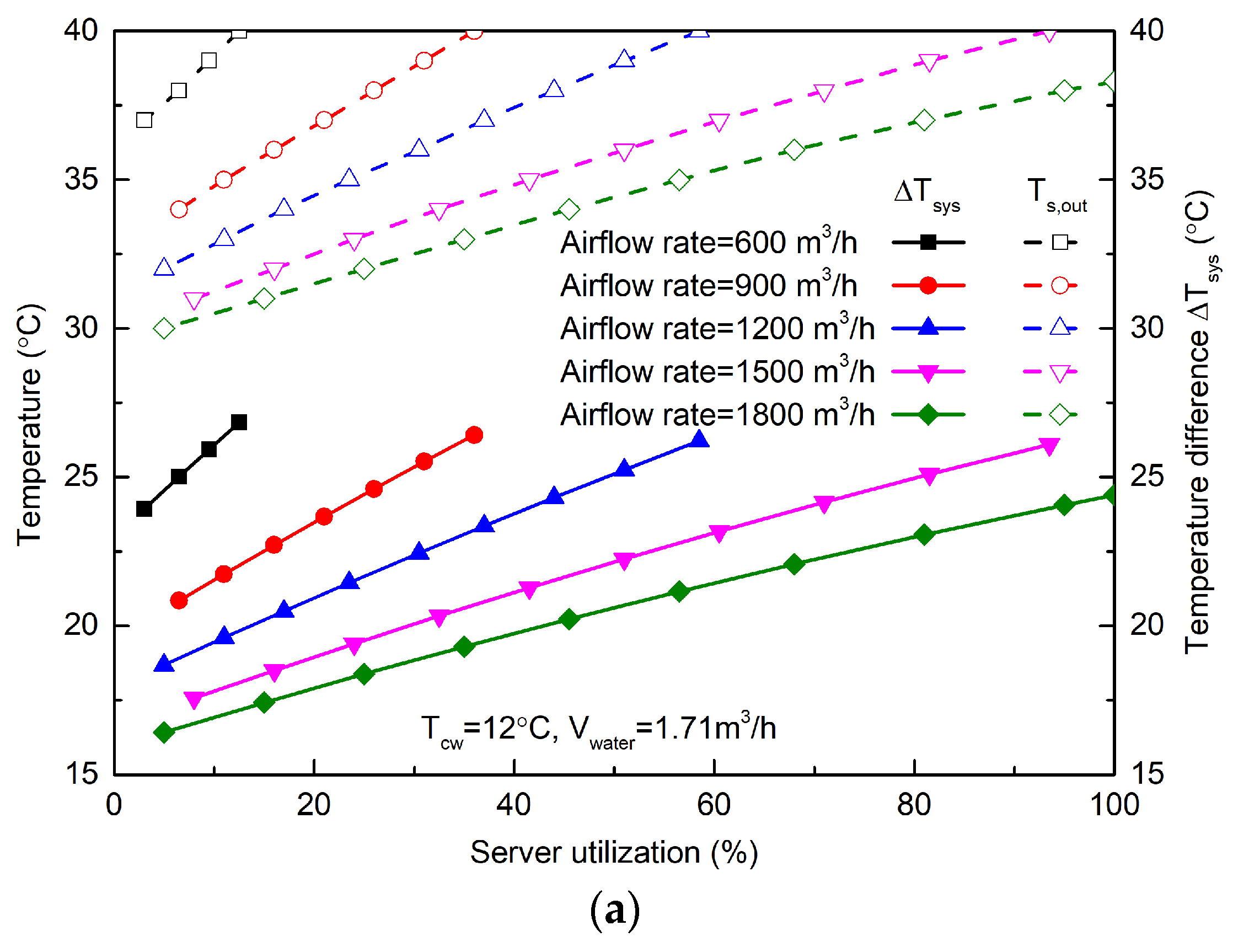
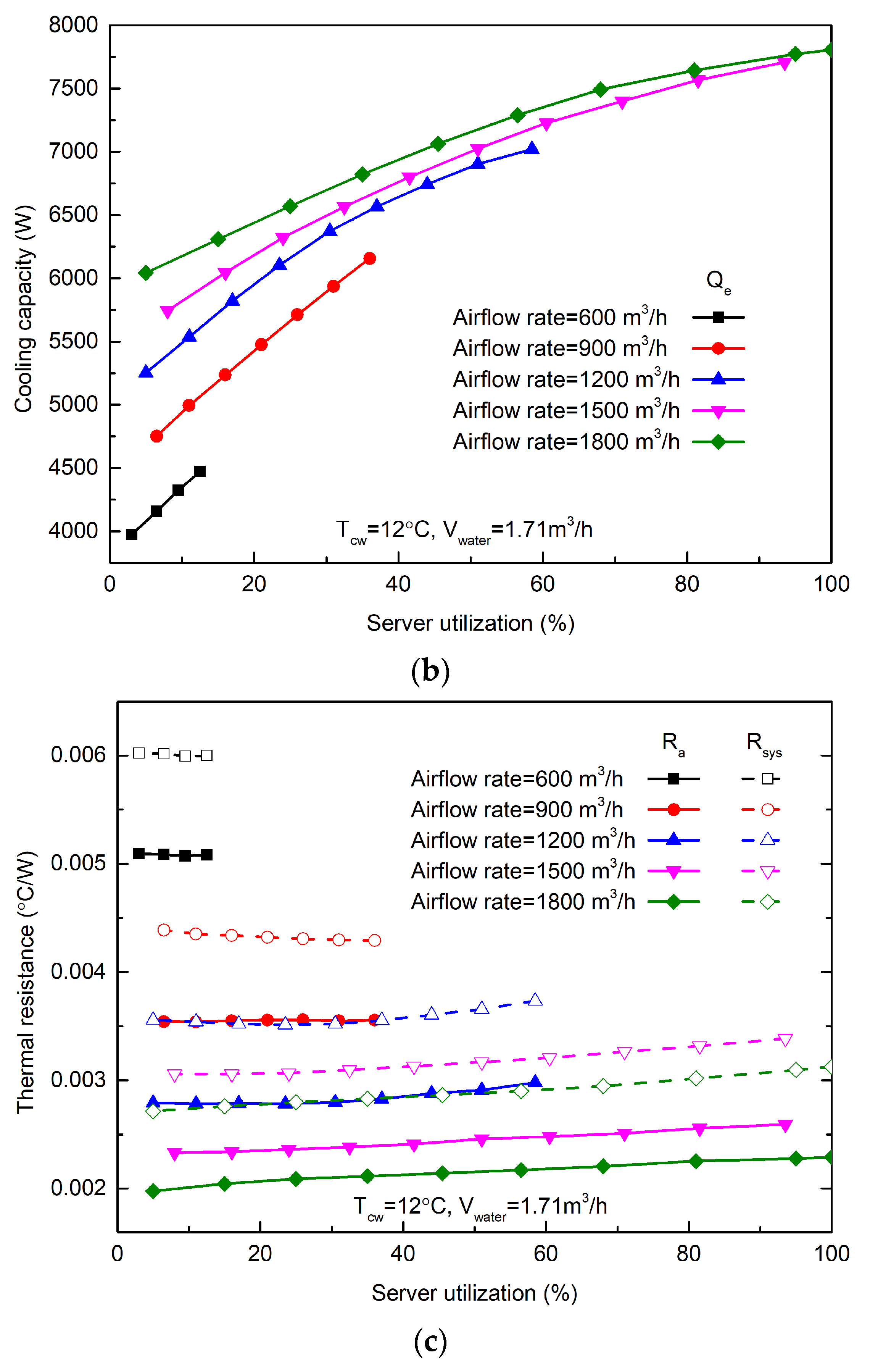
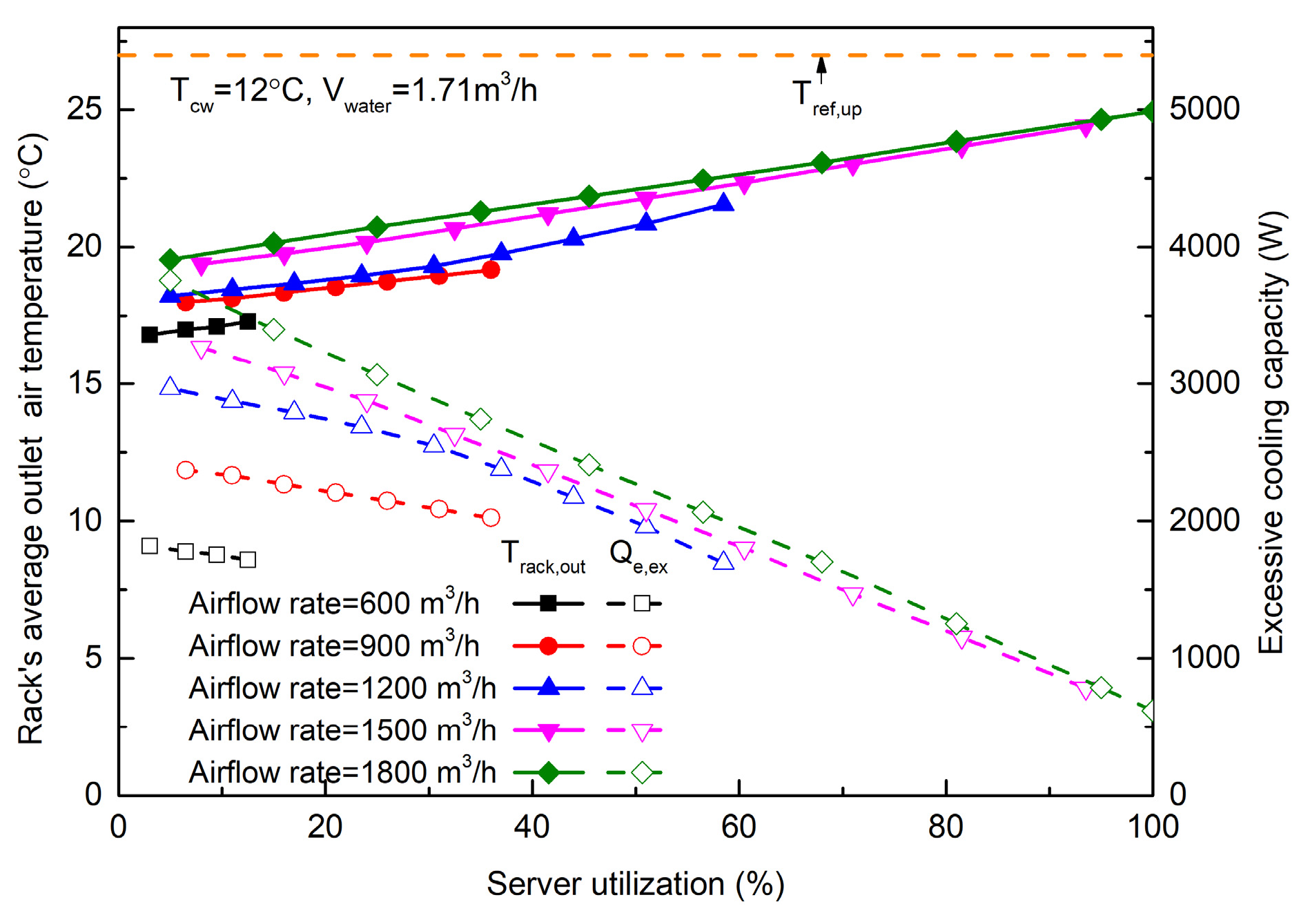
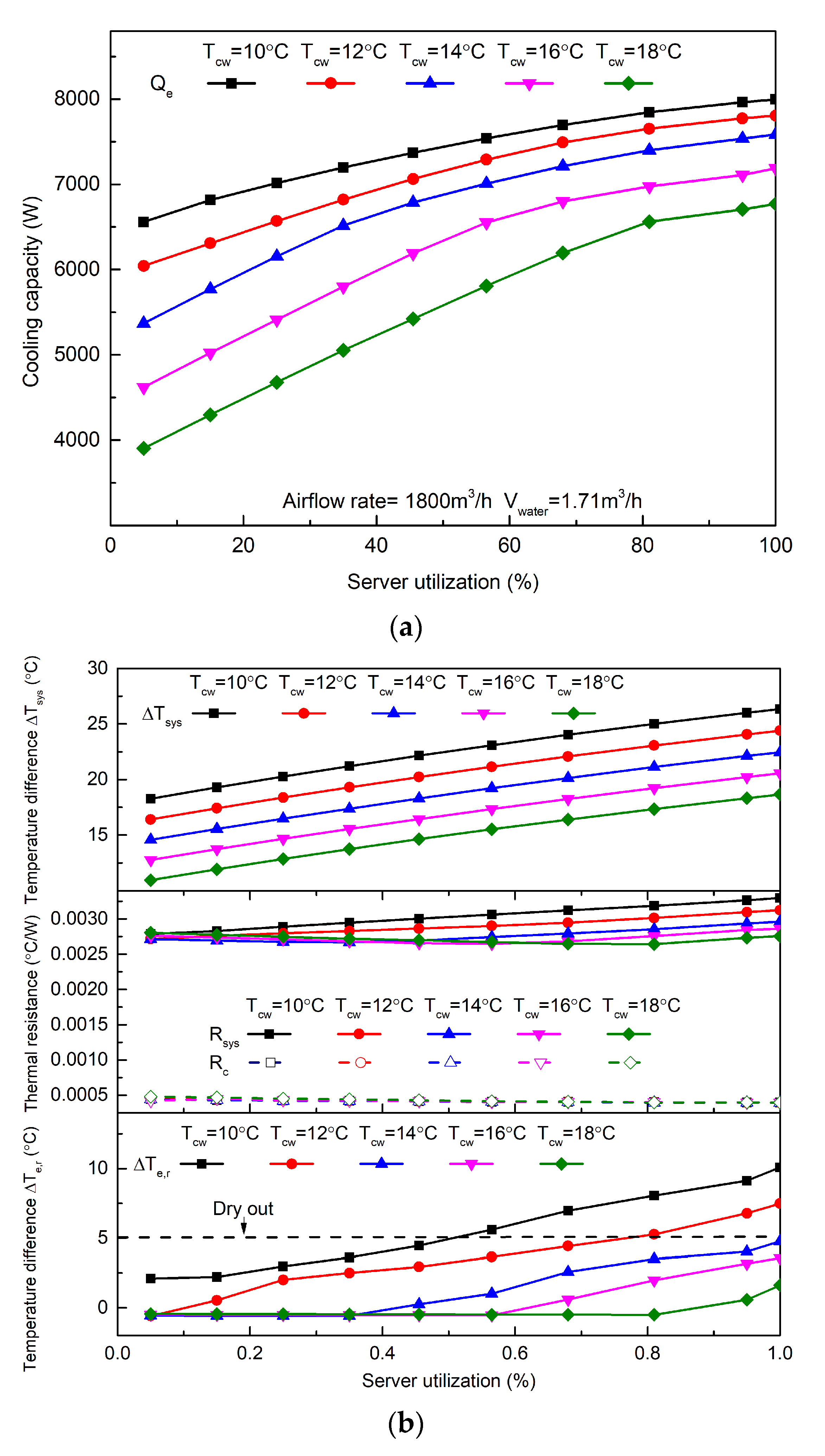
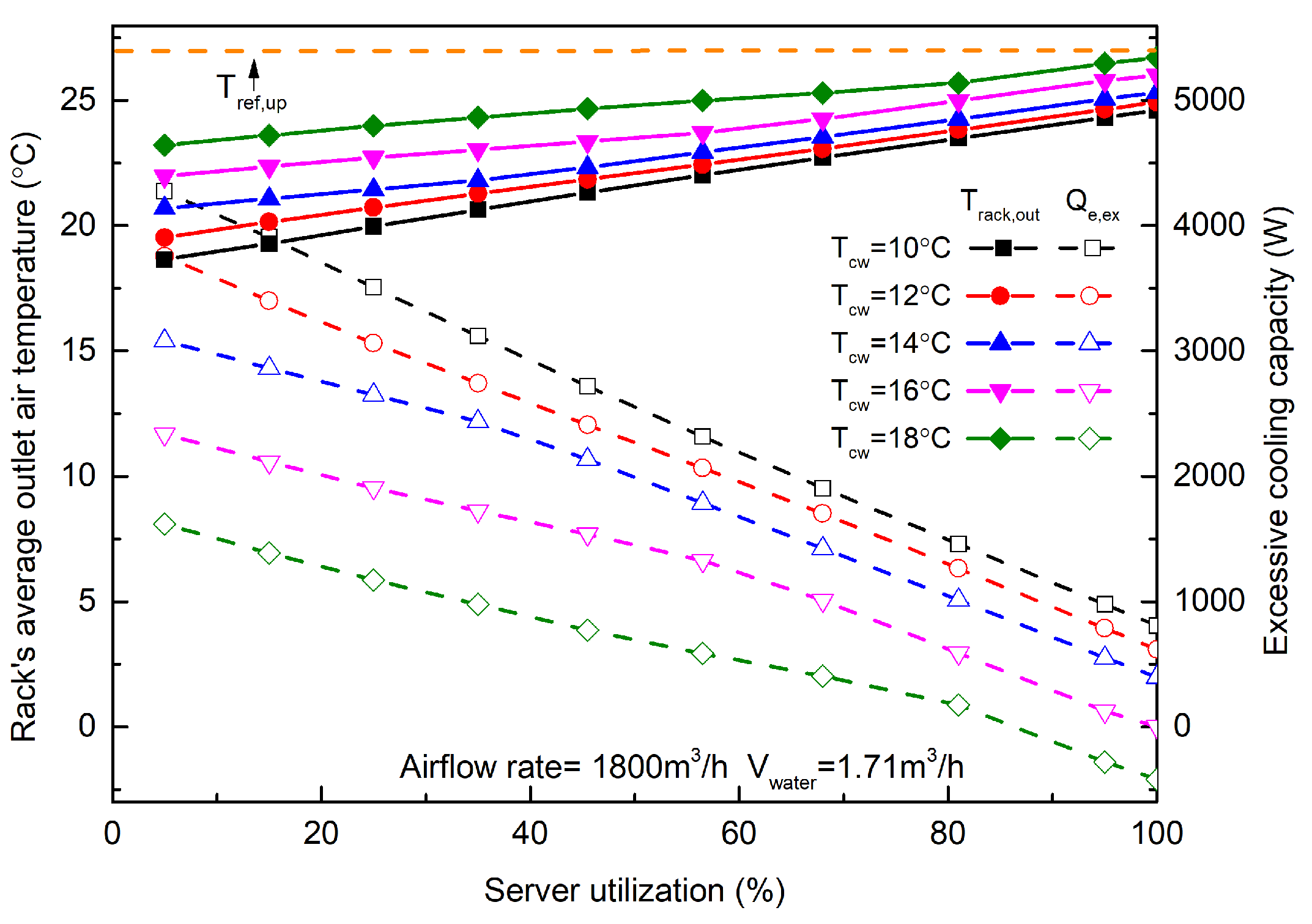
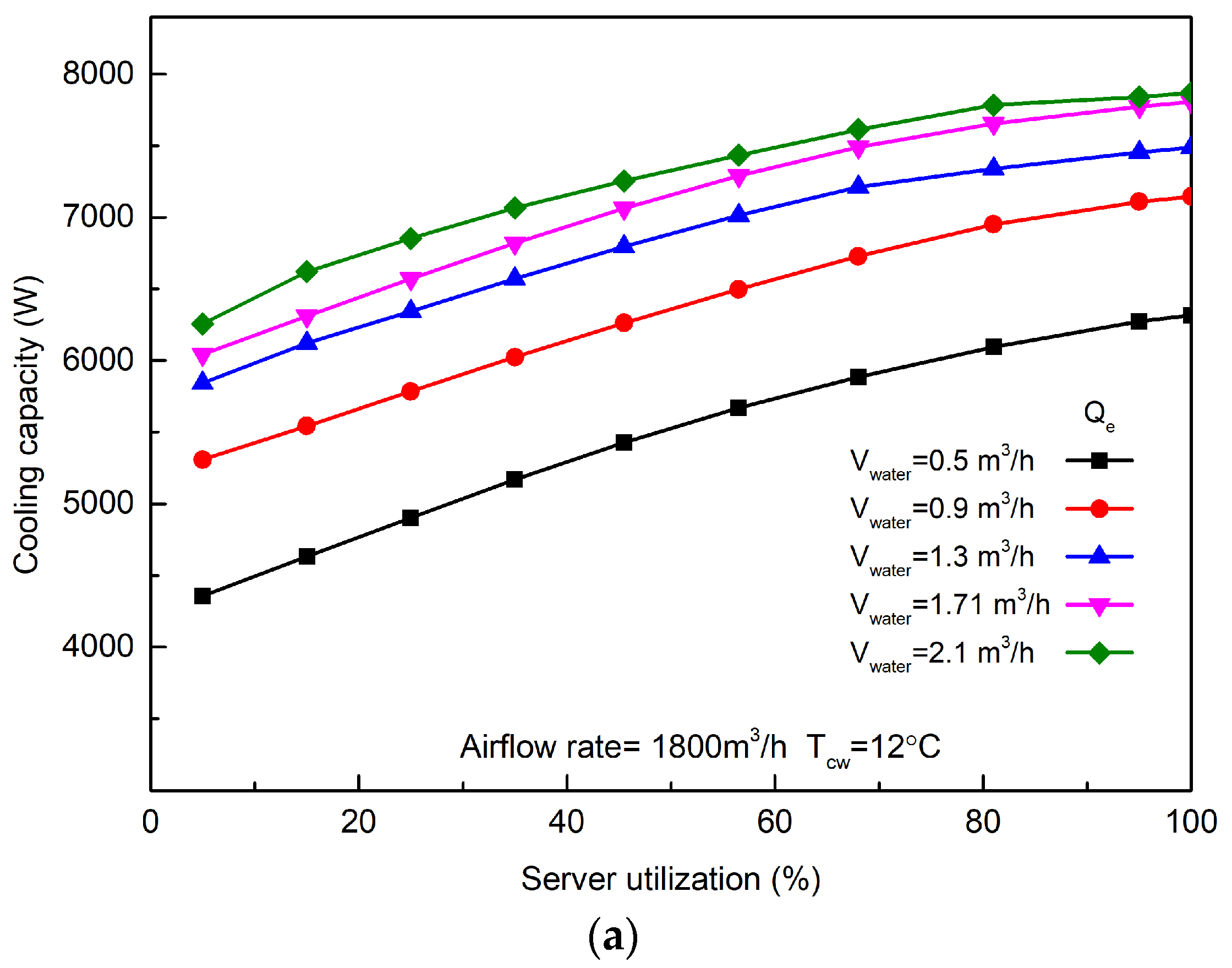


| Structure Parameters | Value | Structure Parameters | Value |
|---|---|---|---|
| Liquid/vapor collector diameter (mm) | 30 | Louver length Lle (mm) | 7 |
| Liquid outlet diameter (mm) | 16 | Louver pitch Pl (mm) | 1 |
| Liquid pipe length Llp (mm) | 4250 | Number of flat tubes | 30 |
| Liquid pipe height difference ΔH (mm) | 2200 | Number of rows | 1 |
| Vapor outlet diameter (mm) | 19 | Number of micro channels in flat tube | 19 |
| Transverse flat tube pitch Pf (mm) | 8 | Plate length (mm) | 466 |
| Micro channel pitch Pm (mm) | 0.4 | Plate width (mm) | 111 |
| Flat tube height Ht (mm) | 2 | Area of the plate (m2) | 0.079 |
| Flat tube width Fw (mm) | 25.4 | Plate thickness (mm) | 0.4 |
| Flat Tube distance (mm) | 1580 | Angle of the corrugation, βc (°) | 30 |
| Fin pitch Fp (mm) | 2 | Corrugation amplitude, b (mm) | 2.4 |
| Fin thickness δf (mm) | 0.105 | Plate pitch, (mm) | 2.8 |
| Fin width Bf (mm) | 25 | Number of plates | 20 |
| Fin height Hf (mm) | 8 | Number of plates effective in heat transfer | 18 |
| Louver angle θ (°) | 30 |
| Parameters | Test Equipment | Range | Uncertainty |
|---|---|---|---|
| Temperature (°C) | Enthalpy difference laboratory | −20~80 | ±0.1 |
| PT100 platinum resistor | −80~150 | ±0.1 | |
| Relative humidity | Enthalpy difference laboratory | 0~95% | ±1% |
| Pressure (kPa) | AKS32 pressure transmitter | −100~300 | ±7.5 |
| Refrigerant mass flow rate (kg/h) | DMF-1-3B Coriolis mass flowmeter | 0~200 | ±1 |
| Airflow rate (m3/h) | Enthalpy difference laboratory | 600~3100 | ±0.3 |
| Water flow rate (m3/h) | Enthalpy difference laboratory | 0~3.2 | 0.5% |
| Range | |
|---|---|
| Refrigerant filling charge (kg) | 0.6, 0.8, 1.0, 1.2, 1.4, 1.6, 1.8 |
| Filling ratio (%) | 27.9, 37.2, 46.5, 55.8, 65.1, 74.4, 83.7 |
| Indoor air dry/wet bulb temperature (°C) | 35/21 |
| Supply chilled water temperature Tcw (°C) | 12 |
| Chilled water flow rate Vw (m3/h) | 1.71 |
| Airflow rate Va (m3/h) | 600, 800,1000, 1200, 1400, 1600, 1800 |
| Working fluid | R22 |
| Working Fluid | Item | Correlation | |
|---|---|---|---|
| Refrigerant | Evaporator single-phase | Heat transfer coefficient | Gnielinski [31] |
| Condenser single-phase | Heat transfer coefficient | Muley and Manglik [32] | |
| Single phase | Pressure drop | Gnielinski [31] | |
| Evaporator two-phase | Heat transfer coefficient | Shah [33] | |
| Pressure drop | Friedel [34] | ||
| Condensation two-phase | Heat transfer coefficient | Han et al. [35] | |
| Pressure drop | Shah [36] | ||
| Connection tubes | Pressure drop | Coleman [37] | |
| Airside | Heat transfer coefficient | Kim and Bullard [38] | |
| Pressure drop | Kim and Bullard [38] | ||
| Water side | Heat transfer coefficient | Muley and Manglik [32] |
| Range | |
|---|---|
| Indoor air dry/wet bulb temperature (°C) | 26/14 |
| Server utilization us (%) | 3–100 |
| Server-rated heating load Ps,full (W) | 7200 |
| Supply chilled water temperature Tcw (°C) | 10, 12, 14, 16, 18 |
| Chilled water flow rate Vw (m3/h) | 0.5, 0.9, 1.3, 1.71, 2.1 |
| Airflow rate Va (m3/h) | 600, 900, 1200, 1500, 1800 |
Disclaimer/Publisher’s Note: The statements, opinions and data contained in all publications are solely those of the individual author(s) and contributor(s) and not of MDPI and/or the editor(s). MDPI and/or the editor(s) disclaim responsibility for any injury to people or property resulting from any ideas, methods, instructions or products referred to in the content. |
© 2023 by the authors. Licensee MDPI, Basel, Switzerland. This article is an open access article distributed under the terms and conditions of the Creative Commons Attribution (CC BY) license (https://creativecommons.org/licenses/by/4.0/).
Share and Cite
Zou, S.; Yue, C.; Xiao, T.; Ma, X.; Wang, Y. Study on Effects of Operating Parameters on a Water-Cooled Loop Thermosyphon System under Partial Server Utilization. Sustainability 2023, 15, 13100. https://doi.org/10.3390/su151713100
Zou S, Yue C, Xiao T, Ma X, Wang Y. Study on Effects of Operating Parameters on a Water-Cooled Loop Thermosyphon System under Partial Server Utilization. Sustainability. 2023; 15(17):13100. https://doi.org/10.3390/su151713100
Chicago/Turabian StyleZou, Sikai, Chang Yue, Ting Xiao, Xingyi Ma, and Yiwei Wang. 2023. "Study on Effects of Operating Parameters on a Water-Cooled Loop Thermosyphon System under Partial Server Utilization" Sustainability 15, no. 17: 13100. https://doi.org/10.3390/su151713100
APA StyleZou, S., Yue, C., Xiao, T., Ma, X., & Wang, Y. (2023). Study on Effects of Operating Parameters on a Water-Cooled Loop Thermosyphon System under Partial Server Utilization. Sustainability, 15(17), 13100. https://doi.org/10.3390/su151713100






